A strong stench of animal waste hangs thick in the air. The residents of plush houses, located near one of Karachi’s best-known addresses, Bilawal House, are forced to keep their windows and doors shut to keep the stink away. A private ‘animal farm’ (comprising Asif Zardari’s pick of animals)-cum-servant quarters, spread over several thousand yards, is the source of this putrid odour. The farm caters to the needs of Bilawal House and is an integral part of this famous residence of Sindh’s first family.
Many of the streets and lanes around the forbidding-walls of Bilawal House also present a picture of neglect and decay. Broken roads and footpaths, piles of garbage, open manholes, a graveyard of junk vehicles, and stray dogs — greet residents and visitors alike in one of Karachi’s most expensive localities: Clifton, Block 3. Here, water ‘tankers’ supply water to opulent bungalows, including Bilawal House, just as they do to many poor, middle-class and affluent neighbourhoods of the city.
“This neighbourhood is symbolic of all that is wrong with Sindh,” says Nargis Rehman, a resident of the area, and convener of Karachi Citizens’ Forum (KCF), an activist organisation that highlights basic civic issues of the megacity and advocates establishment of an empowered local bodies system.
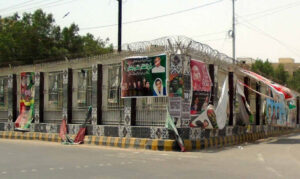
“If they can’t look after their own area, how can they take responsibility for the entire province?” asks Rehman, whose house is located in a lane adjacent to the high walls surrounding Bilawal House and its affiliate properties. “This is supposed to be one of the most expensive localities, but what do we see here? We can’t even keep our windows and doors open because of the foul smell. Bilawal House’s animal farm remains a bane for the neighbourhood, but we cannot do anything about it. The issue was even taken up with the commissioner (Karachi), and he advised us to talk to Bilawal. Why? Can’t the authorities act on merit? Why the special privileges for a select few?”
Over the years, there has been a rapid deterioration in the civic amenities and the look and feel of the neighbourhood, where Bilawal House is located. The once wide and open Khayaban-e-Saadi gives a claustrophobic look because of the erection of a fence in the middle of this two-way carriage and a wall running parallel to the blocks of apartments overlooking one side of the high walls surrounding Bilawal House. A couple of check posts have also been constructed, not on the footpath, but on one part of the road. These extra security arrangements — well outside the parameters of Bilawal House — are not just an eyesore, but also hurt the businesses of shopkeepers in the apartment blocks. After several unsuccessful protests by rival political parties and civil society members, the area residents have resigned to their fate, and the fact that Bilawal House, wall, fence et al are going nowhere.
For Nargis Rehman, along with the overall decay in the civic amenities and infrastructure of the area, the new and old banners, flags and photographs of politicians, mostly belonging to the Pakistan People’s Party (PPP), add to the overall grotesque look of the area.
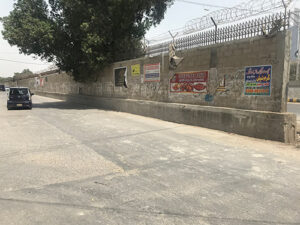
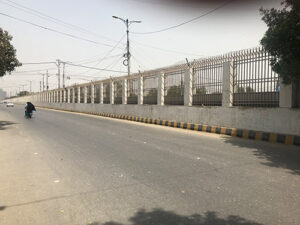
However, Sindh Government’s Minister for Local Bodies and Information, Syed Nasir Hussain Shah, begs to differ: He says that a lot of development work has been undertaken in the recent past to improve Clifton’s Block 3, including its roads and drainage system. “A one plus kilometre-long park has been built (on the other side of Khayaban-e-Saadi), while roads and streets have been carpeted… the remaining ones will be repaired soon,” he says. (See Syed Nasir Hussain Shah’s detailed interview on page 26).
But residents of the area remain dissatisfied — it’s too little and too late.
No matter how symbolic Bilawal House and its vicinity may appear in understanding the tragedy of Karachi, they comprise only a very tiny part of this sprawling megapolis — which is among the world’s top 12 largest cities.
As one moves away from the “posh” neighbourhoods of Clifton and the Defence Housing Authority (DHA) in District South — both of which were inundated in last August’s record rains —or other affluent and upper middle and middle-class neighbourhoods, including PECHS, Mohammed Ali Society, Karsaz and Gulshan-e-Iqbal in District East, towards the low-income or poor neighbourhoods, the tragedy of Karachi becomes more and more pronounced.
Barring a few private and official islands of privilege, Karachi is one of the most chaotic and dysfunctional cities of the world.
No wonder a 2018 World Bank report counted it among the 10 most unlivable cities on the planet. Even by Pakistani standards, Karachi — the economic backbone of Pakistan — lags behind even Lahore and Rawalpindi/Islamabad — the second and the fourth largest cities of Pakistan respectively.
A recent report by the reputed ‘The Economist Intelligence Unit’ ranked Karachi as the fifth most unlivable city in the world, based on its poor infrastructure, lack of public transport, poor housing and living standards, abysmal public healthcare and education systems, and widespread problems of crime, violence and political instability.
This is perhaps the only megacity of the world which, to date, is devoid of a mass transit system or even some sort of decent, passable public transport. Lahore, Rawalpindi-Islamabad, Peshawar and even Multan have some modern public transport available, but not Karachi. The result is the rising number of smaller vehicles, which are not just choking the roads and streets, but adding to the overall noise and air pollution.
Whether it is about solid waste collection or keeping the stormwater drains clean or the sewerage lines operational, all these tasks which were once being performed smoothly, have now become a headache. Piles of garbage are littered on almost every nook and corner of the city. Due to the failure of the authorities to cart the garbage to landfill sites, it is being set ablaze, which adds to the air pollution. Similarly, already choked stormwater drains are further being used to throw solid waste, leading to flooding even in normal and below-normal rains. Keeping them clean and free of encroachments is a battle which the authorities seem to be losing all the time.
Water distribution in the city has been taken over by the water tankers’ mafia — from low-income neighbourhoods to the elite ones, all bank on them as piped water supply remains a luxury in most parts of the city.
The depleted sewerage and water distribution lines further complicate the challenge of Karachi as authorities have, over the years, kept allowing commercialisation and construction of high-rise buildings on small residential plots in an unplanned manner. As a result, a residential plot meant for one family, is now catering for dozens — and parking is not the only problem. Even the original sewerage and water distribution lines are not equipped to meet the 100 fold pressure on them.
Dr. Qaiser Sajjad, secretary-general of the Pakistan Medical Association, says that the depleted pipe network results in contamination of water as sewage water seeps into the potable waterlines. “If citizens were to start getting clean water, there would be more than a 50 percent decline in the number of common diseases, including gastrointestinal disorders, cholera, typhoid and Hepatitis A and B,” he maintains. “Additionally air pollution due to the burning of solid waste plus industrial and traffic pollution is responsible for diseases of the upper and lower respiratory tract and various allergies. It’s like slow poisoning, especially in those areas where factories are located in the middle of residential neighbourhoods.”
Unfortunately, there are no mid- to long-term policies in place to fight and curb pollution. These issues hardly figure on the Sindh Government’s priority list, though provincial and federal ministers and leaders of the mainstream parties do keep paying lip-service to the cause.
Dr. Sajjad, while giving specific examples of hazardous air pollution, shares that in Old Golimar, a low-income locality of Karachi, marble factories have sprung up on the roads. “The atmosphere there is dense with small marble particles floating in the air due to its constant cutting and grinding. As a result, residents of the area suffer from acute lung and respiratory diseases, including cancer.”
Untreated toxic industrial waste and sewerage water is being used on the outskirts of Karachi for growing vegetables. When the scandal broke out, the superior judiciary took notice of it but there is still no guarantee that Karachiites are getting safe food supplies.
“Everything seems to be falling apart but little is being done to improve the situation except for some patchwork here and there. Perhaps, the message being transmitted by those in power is that we reconcile to our miseries and accept misgovernance as a way of life,” laments Nargis Rehman. “We have seen those days when girls from middle-and upper-middle classes in Karachi could travel by bus alone or the families could venture out along with kids late at night; this is impossible today.”
Last year, after torrential rains hit Karachi, the federal government announced a 1.1 trillion rupee package, under five heads of utilisation. (Table 1) While the civil society and experts welcomed the package and formation of a committee to monitor the implementation of the Karachi Package and other relevant issues, concerns remained that the initiative announced jointly by the federal and Sindh governments failed to include any structural reforms, which are a must to handle the problems of this megacity.
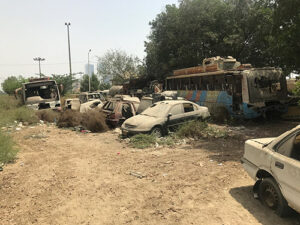
Instead of adopting a holistic approach, the federal and the provincial governments went for stop-gap, populist measures that appeared good on paper, but missed the main problem: the absence of a centralised and empowered local government system.

In fact, none of the major political parties — from the Pakistan Tehreek-e-Insaaf (PTI) to the PPP to the Pakistan Muslim League-Nawaz (PML-N) — even appear serious about it.
The PPP, which enjoys a comfortable majority in the Sindh Assembly, could single-handedly have changed the face of Karachi during its 13-year consecutive rule, but the alleged apathy, indifference and corruption of its leadership is overwhelmingly being blamed for Karachi’s plight. The strong criticism of the PPP does not it any way mean that the other representative parties have served Karachi any better. The Muttahida Qaumi Movement (MQM), even in its heydays, did little to press for structural reforms for the city or take measures which would resolve its issues on a long-term basis. As allies of various parties — from the PPP and the PML-N to the PTI now — the MQM got the ministries of its choice and dictated the politics of Karachi for decades, but it did not press for holistic changes in the way the city is governed. Its consistent demands for empowered local bodies and even a separate province appear more directed towards short-term political gains rather than a commitment to any of these goals.
The PTI, which got substantial votes in the 2013 elections and won the biggest chunk of National Assembly seats from the city in 2018, has also not been able to fulfil its promises — both because of its skewed priorities and the federation’s minimal role in provincial matters after the controversial 18th Amendment.
These three major parties also failed to build a consensus on any meaningful reforms that could have resulted in an empowered and centralised local bodies system, which exists in other major cities of the world.
Empowered and centralised local bodies are vital for Karachi as its land control is divided among 19 civic agencies of six cantonments, the Civil Aviation Authority, Pakistan Railways, the Karachi Port Trust, the Port Qasim Authority, the Karachi Metropolitan Corporation, six District Municipal Corporations, the Lyari Development Authority, the Sindh Building Control Authority, the Sindh Solid Waste Management Board and the Karachi Water and Sewerage Board. Unfortunately, there is no centralised coordination among them, as each one of them jealously guards its domain and interest.
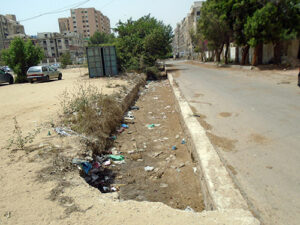
Nargis Rehman of KCF shares that the only time she remembers Karachi as being a priority for development was in the times of former military ruler, President Gen. Pervez Musharraf. “He empowered the local bodies and gave Karachi lots of funds. The PPP, which has been ruling the province since 2008, could have changed the face of Karachi and Sindh, but unfortunately matters have gone from bad to worse.”
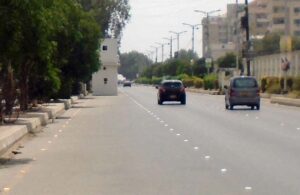
They undid whatever good Musharraf had done, by crippling the local bodies system through the Sindh Local Government Act 2013.
A huge city like Karachi would not be needing funds from the provincial or the federal governments, or even the Karachi Package, had the city been given administrative and financial powers and a centralised and autonomous city government, which could have generated its own resources, from taxes and levies, such as the motor vehicle and property taxes. But the problem is that the political stakeholders, especially the PPP, which is seen as a representative of the interests of the rural elite, are not ready for any such arrangement, which should not just be confined to Karachi, but also extended to the other major and secondary cities of Sindh and other parts of the country.
Obviously, such an arrangement would hurt the interests of major political parties, which, after the 18th Amendment, treat the provinces as their personal fiefdoms. All powers are concentrated in the hands of the chief minister and his cabinet, rather than being devolved to the grassroots level, as was the case in Musharraf’s tenure.
It is ironic that while the provinces fight to get their share in the National Finance Commission Award, they refrain from implementing the Provincial Finance Commission Award themselves.
Some civil society members are of the view that, all political parties have failed Karachi and refuse to take its practical ownership. This is unlike Lahore, where the PML-N took charge and made development its top priority.
An efficiently governed Karachi has enough potential to drive not just its own economy and that of Sindh, but of the entire country. But for this to happen, certain basic structural flaws need to be fixed and political parties have to not just break their present mould of politics, which is overwhelmingly ethnic, but evolve a consensus on how to manage and run 21st Century cities by devolving powers. This, however, does not appear to be on their agenda, and Karachi, with all its unresolved contradictions and mega-problems, continues to sit on a powder keg.


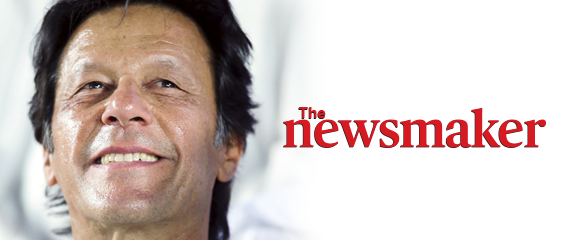

Karachi seems to have been left to fend for itself with no one willing to take ownership of the problems the city faces. The ruling PPP seems happy to let it writhe in its misery
But Karachi may prove to be the power keg which may propel not not the mega city but the entire country to a well deserved upheaval leading to a revolution of the people
That’s PPP democratic revenge from this city. Instead of alleviating the shambolic state of the rest of Sindh, they have destroyed Karachi to make every corner look the same. Wow, the shit has hit the fan here. I don’t want the Bilawal House area be cleaned up ever. No, it shouldn’t be. Rather, it should be made a large garbage station inviting the whole city’s trash. Not just that, the Bilawal House should be made a dog hound too, where Asifa should be welcoming all the stray, rabid dogs responsible for hundreds of deaths every day. But all the Karachiites can’t absolve themselves from being a partner in crime. We claim to be the “best Muslims” this world has ever seen, yet we never clean up the ramps in front of our houses! We are at the lowest ebb of values, much closer to the ubiquitous dogs, kites and crows that are now half of the city’s human populace, if not equal.